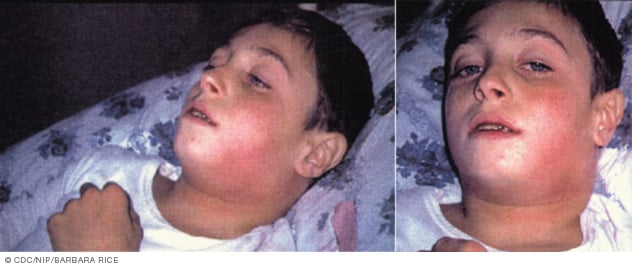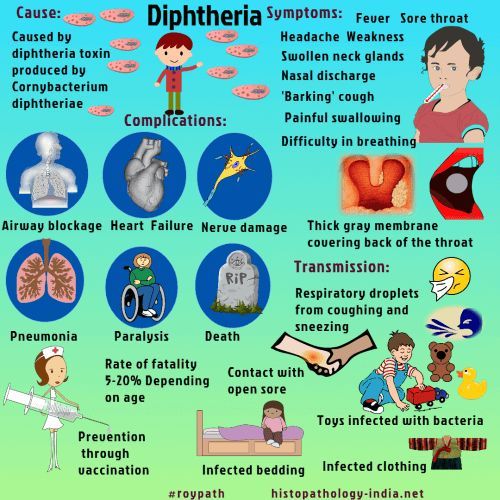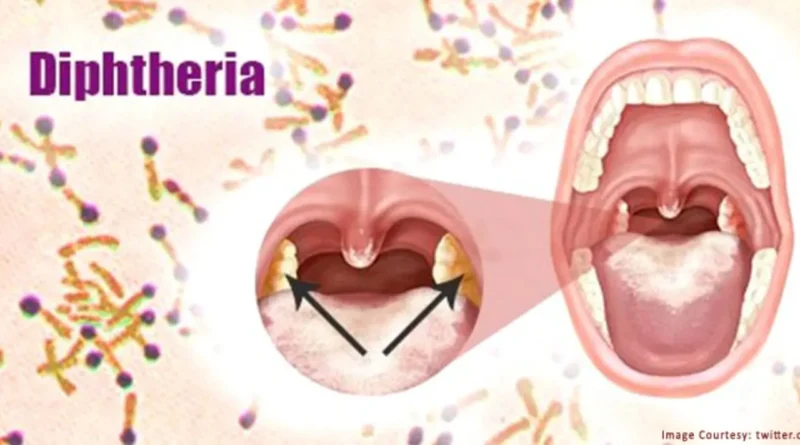Diphtheria – Symptoms, Causes and Treatment
The term diphtheria is derived from a Greek word meaning leather. It refers to a severe infection, generally affecting the upper respiratory passages. It is essentially a disease of children and occurs very rarely in adult life.

Diphtheria is highly contagious and is caused by certain germs occasionally found in the throat of apparently normal persons. The highest incidence of this disease occurs in cool season, but It can occur any time. The incubation period is usually from four to six days.
Symptoms
The onset of diphtheria is mild and often uncertain. The disease often looks like tonsillitis in the early stages. There may be fever ranging from 101 to 104 degree F and soreness of the throat. The patient feels weak and depressed. A membrane appears generally on one tonsil and in rare cases, on both the tonsils. This gradually increase in size. It may be thick or thin, grey or brownish in colour and is surrounded by a zone of red inflammation.
The membrane may be restricted to tonsils, or it may involve the whole of the back of the throat and soft palate. It may extend upward into the nose or downward into the larynx. Diphtheria can also occur without the false membrane with tissues being red and swollen and the bacilli being present. The glands of the neck are usually enlarged, and when the nose is involved, they increase rapidly in size.

The patient is very low in spirits and rapidly become anaemic and pale. Unless treated properly, he may die from steadily increasing debility or from rapid weakening of the heart due to toxins of diphtheria. In favorable cases, the symptoms gradually subside and the membranes slowly disappear. The duration of the disease ranges from a few days to two or three weeks.
Causes
Diphtheria is caused by an organism known as Corynebacterium diphtheriae. This bacterium multiplies in the throat and nose. Droplets and discharges from the throat of an infected person spread the disease to susceptible persons. This is the major mode off spread of the infection. Sometimes, milk and similar substances also serve as vehicles for the spread of this disease.
Thus, the immediate cause of diphtheria, according to medical views, is germ infection. However, no person can catch this disease if he does not have the basis for its propagation in his system, in the form of morbid matter and toxic wastes, brought about by wrong feeding and unhygienic living.

Complications
Children with large tonsils and adenoids are more susceptible to diphtheria, especially if they have not been given the DPT shot in infancy. Greatest danger arises from blockage of the windpipe due to the infection in the throat. This causes strangling. The disease may also damage the heart, the brain and the kidneys. The toxins are carried to these areas by the blood stream. Heart failure may occur due to weakened muscle fibres which are unable to contract as they should.
Treatment
The use of anti-toxins for the treatment of diphtheria may sometimes prove apparently successful. The patient should be given only orange juice and water in small quantities. This will provide energy, increase urinary output and promote body resistance against infection, thereby facilitating recovery. A warm-water enema should be administered daily during this period to cleanse the bowels.
The patient of diphtheria should be kept in bed and isolated from others for four to six weeks. To avoid the swallowing of the secretion constantly forming in the mouth during the fever, the patient should sleep on his sides and not allowed to lie on his back. Some absorbent cotton may be arranged in the mouth to absorb much of this matter. This can be renewed several times a day as required.

The moist hot inhalation will be beneficial in the treatment of this condition. It will aid greatly in maintaining the resistance of the tissues and facilitates the separation of the membranes. Another valuable application is the wet pack to the throat.
If the above treatment is faithfully carried out, the fever will run its course without any trouble and complications or serious after effects. The patient can then be placed on an all-fruit diet for few days. Thereafter, he may be allowed to gradually embark upon a well-balanced diet. The emphasis should be on whole grain cereals, fresh fruits and raw or lightly cooked vegetables.




